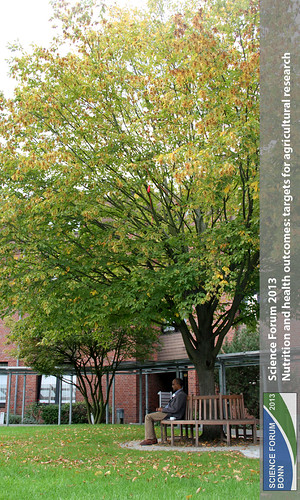
We might often think of trees from an ecological point of view, delivering ecosystem services such as carbon sequestration or preventing soil erosion. But what about their dietary value? How can they contribute to improve food security and nutrition?
Do children in areas with more trees have more diverse diets? Amy Ickowitz from the Center for International Forestry Research (CIFR) addressed these questions during her presentation “Role for forests for nutrition” during the session “Diet diversification”.
CIFR has started a two years research project comparing diets in villages in Uganda, Ethiopia, Cameroon, Zambia and Burkina Faso with varying percentage of tree cover. The preliminary results show a relationship between tree cover and dietary diversity. However, there are still many areas to be explored and many “How” and “Why” questions to be answered, as Ms. Ickowitz stressed.
Given the global urbanization process going on around the world, it would also be interesting to see examples or studies of how trees can contribute to enhance food security and nutrition in cities?
Are cities with more trees increasing diet diversity for their urban citizens? Should agricultural scientists respond to this question or should I better ask an urban planner or a nutritionist? Who should feel responsible to engange in this research field? Maybe the next time I am lucky and there will be also urban planners among the audience. This shows what was often discussed in the “Diet Diversification” breaktout session:
interdisciplinary collaboration is the key for linking agriculture and nutrition…but how much are we really willing to collaborate with others?
 We might often think of trees from an ecological point of view, delivering ecosystem services such as carbon sequestration or preventing soil erosion. But what about their dietary value? How can they contribute to improve food security and nutrition? Do children in areas with more trees have more diverse diets? Amy Ickowitz from the Center for International Forestry Research (CIFR) addressed these questions during her presentation “Role for forests for nutrition” during the session “Diet diversification”.
CIFR has started a two years research project comparing diets in villages in Uganda, Ethiopia, Cameroon, Zambia and Burkina Faso with varying percentage of tree cover. The preliminary results show a relationship between tree cover and dietary diversity. However, there are still many areas to be explored and many “How” and “Why” questions to be answered, as Ms. Ickowitz stressed.
Given the global urbanization process going on around the world, it would also be interesting to see examples or studies of how trees can contribute to enhance food security and nutrition in cities? Are cities with more trees increasing diet diversity for their urban citizens? Should agricultural scientists respond to this question or should I better ask an urban planner or a nutritionist? Who should feel responsible to engange in this research field? Maybe the next time I am lucky and there will be also urban planners among the audience. This shows what was often discussed in the “Diet Diversification” breaktout session: interdisciplinary collaboration is the key for linking agriculture and nutrition…but how much are we really willing to collaborate with others?
We might often think of trees from an ecological point of view, delivering ecosystem services such as carbon sequestration or preventing soil erosion. But what about their dietary value? How can they contribute to improve food security and nutrition? Do children in areas with more trees have more diverse diets? Amy Ickowitz from the Center for International Forestry Research (CIFR) addressed these questions during her presentation “Role for forests for nutrition” during the session “Diet diversification”.
CIFR has started a two years research project comparing diets in villages in Uganda, Ethiopia, Cameroon, Zambia and Burkina Faso with varying percentage of tree cover. The preliminary results show a relationship between tree cover and dietary diversity. However, there are still many areas to be explored and many “How” and “Why” questions to be answered, as Ms. Ickowitz stressed.
Given the global urbanization process going on around the world, it would also be interesting to see examples or studies of how trees can contribute to enhance food security and nutrition in cities? Are cities with more trees increasing diet diversity for their urban citizens? Should agricultural scientists respond to this question or should I better ask an urban planner or a nutritionist? Who should feel responsible to engange in this research field? Maybe the next time I am lucky and there will be also urban planners among the audience. This shows what was often discussed in the “Diet Diversification” breaktout session: interdisciplinary collaboration is the key for linking agriculture and nutrition…but how much are we really willing to collaborate with others? 




Comments
Post new comment